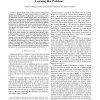Free Online Productivity Tools
i2Speak
i2Symbol
i2OCR
iTex2Img
iWeb2Print
iWeb2Shot
i2Type
iPdf2Split
iPdf2Merge
i2Bopomofo
i2Arabic
i2Style
i2Image
i2PDF
iLatex2Rtf
Sci2ools
84
Voted
CEC
2007
IEEE
2007
IEEE
Evolving neuromodulatory topologies for reinforcement learning-like problems
— Environments with varying reward contingencies constitute a challenge to many living creatures. In such conditions, animals capable of adaptation and learning derive an advantage. Recent studies suggest that neuromodulatory dynamics are a key factor in regulating learning and adaptivity when reward conditions are subject to variability. In biological neural networks, specific circuits generate modulatory signals, particularly in situations that involve learning cues such as a reward or novel stimuli. Modulatory signals are then broadcast and applied onto target synapses to activate or regulate synaptic plasticity. Artificial neural models that include modulatory dynamics could prove their potential in uncertain environments when online learning is required. However, a topology that synthesises and delivers modulatory signals to target synapses must be devised. So far, only handcrafted architectures of such kind have been attempted. Here we show that modulatory topologies can be d...
| Added | 02 Jun 2010 |
| Updated | 02 Jun 2010 |
| Type | Conference |
| Year | 2007 |
| Where | CEC |
| Authors | Andrea Soltoggio, Peter Dürr, Claudio Mattiussi, Dario Floreano |
Comments (0)

